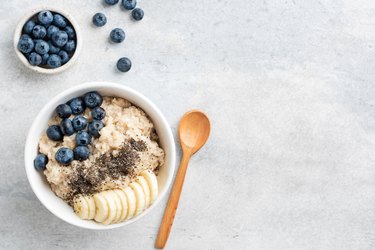
That packet of oatmeal might seem ideal for a quick breakfast, but it's not necessarily ideal for your health. Oatmeal has benefits and disadvantages that depend largely on the type of oatmeal you eat.
If you're eating oatmeal for digestive issues and general health, it's important to choose minimally processed oatmeal. Digestion time will be longer, blood sugar will be more stable and the health benefits will be more pronounced.
Video of the Day
Video of the Day
Tip
You may find benefits from eating oats for digestion, primarily due to the fiber content. With minimally processed oatmeal, digestion time is slower and there are greater health benefits.
Eat Oats for Digestion
Oats contain significant amounts of dietary fiber, especially a type known as beta-glucan fiber, according to February 2015 research published in the Journal of Food Science and Technology.
Beta-glucan may slow digestion, increase satiety and suppress appetite, says the Harvard T.H. Chan School of Public Health. It assists in moving cholesterol-rich bile acids through the digestive tract and out of the body.
The benefits of eating oats for digestion also have to do with their phenolic compounds and phytoestrogens, which serve as antioxidants, adds the Harvard School of Public Health. These plant chemicals help to reduce the damaging effects of inflammation resulting from cardiovascular disease, diabetes and other conditions.
Furthermore, beta-glucan fiber may protect against colon cancer, says the J__ournal of Food Science and Technology. Whole grain oats also contain important nutrients, including unsaturated fatty acids, vitamin E, folate, zinc, iron, selenium, copper, manganese, carotenoids and choline.
Read more: 10 Myths About Grains — Totally Busted
Importance of Fiber
Beta-glucan is a soluble fiber, meaning it dissolves in water to form a gel-like material, explains the Mayo Clinic. Soluble fiber is found in not only oats, but also peas, beans, apples, citrus fruits, carrots, barley and psyllium. Insoluble fiber — found in whole wheat flour, wheat bran, nuts, beans and vegetables — helps to move material through your digestive system and increases stool bulk.
Both soluble and insoluble fiber are important parts of a healthy diet. Because fiber is not digested or absorbed — unlike fats, proteins and carbohydrates — it passes relatively intact through the digestive system and out of your body. The Mayo Clinic notes several different benefits of eating a wide variety of high-fiber foods:
- Normalizes bowel movements and decreases constipation by increasing stool size and softening stools
- Maintains bowel health and decreases the risk of hemorrhoids and colorectal cancer
- Soluble fiber in oats, oat bran, beans and flaxseed reduces low-density lipoprotein ("bad") cholesterol, may reduce blood pressure and inflammation, and helps to regulate blood sugar levels
- Assists with weight management and weight loss by promoting feelings of satiety
The 2015-2020 Dietary Guidelines for Americans recommend women get about 25 grams of fiber a day, and men, about 30 — depending on age. However, most Americans fall short of meeting those recommendations, according to American Journal of Lifestyle Medicine research published in January 2017.
Eating more whole grains like whole oats — along with a variety of fruits and vegetables — can help to meet the fiber intake recommendations. The Dietary Guidelines advise that at least half the grains you eat should come from whole grains.
Oatmeal Benefits and Disadvantages
Eating whole grains boosts your health in other ways, too. According to a review published in the British Journal of Nutrition (BJN) in October 2015, whole grain oats can help to control blood glucose.
The same is not true of oats that have undergone processing, however. For example, quick-cooking oats and instant oatmeal have been shown to produce a higher glycemic response than large-flake oatmeal porridge, muesli and granola, according to the BJN review.
The nutritional content of steel-cut and instant oats is similar, adds the Harvard School of Public Health. However, they affect blood sugar differently.
With minimally processed oatmeal, digestion time is longer and there is a reduced glycemic load. In contrast, more highly processed oats move more rapidly through the digestive system and may spike blood sugar. The Harvard School of Public Health lists oats in the following order, from least to most processed:
- Oat groats: Whole oat kernels with intact germ, endosperm and bran. Oat bran may be removed and eaten as cereal or added to recipes to boost fiber content.
- Steel-cut or Irish: Oat groats that have been cut into smaller pieces using a steel blade.
- Scottish oats: Stone-ground oat groats that have a porridge-like texture when cooked.
- Rolled or old-fashioned oats: Steamed, rolled and flattened oat groats, dried to remove moisture.
- Quick or instant: Oat groats that have been steamed and rolled into thin pieces to readily absorb water and cook quickly.
To ensure you're gaining the greatest oatmeal benefits and not disadvantages, avoid products with added sugars, and eat whole-grain oats that have been minimally processed. It may take you a bit longer to prepare them, but your health is worth the extra time.
Read more: 13 Powerful Grains and Seeds
- Journal of Food Science and Technology: "Nutritional Advantages of Oats and Opportunities for Its Processing as Value Added Foods - a Review"
- British Journal of Nutrition: "Systematic Review of the Effect of Processing of Whole-Grain Oat Cereals on Glycaemic Response"
- Mayo Clinic: "Dietary Fiber: Essential for a Healthy Diet"
- 2015-2020 Dietary Guidelines for Americans: "Appendix 7. Nutritional Goals for Age-Sex Groups Based on Dietary Reference Intakes and Dietary Guidelines Recommendations"
- 2015-2020 Dietary Guidelines for Americans: "Key Elements of Healthy Eating Patterns"
- Harvard T.H. Chan School of Public Health: "Oats"
- American Journal of Lifestyle Medicine: "Closing America’s Fiber Intake Gap"
Was this article helpful?
150 Characters Max
0/150
Thank you for sharing!
Thank you for your feedback!